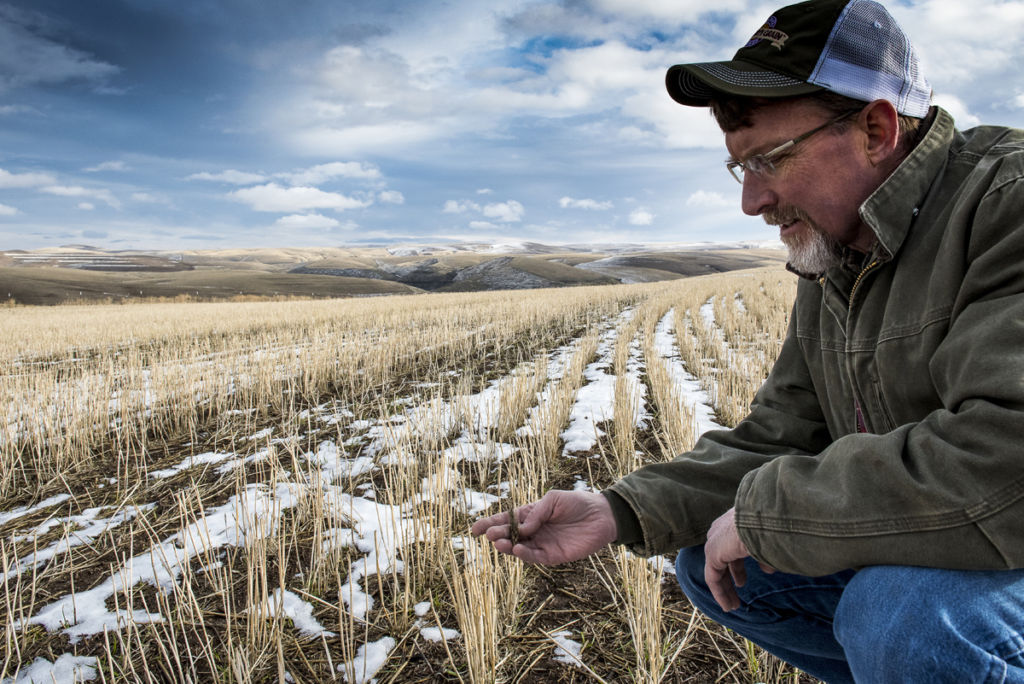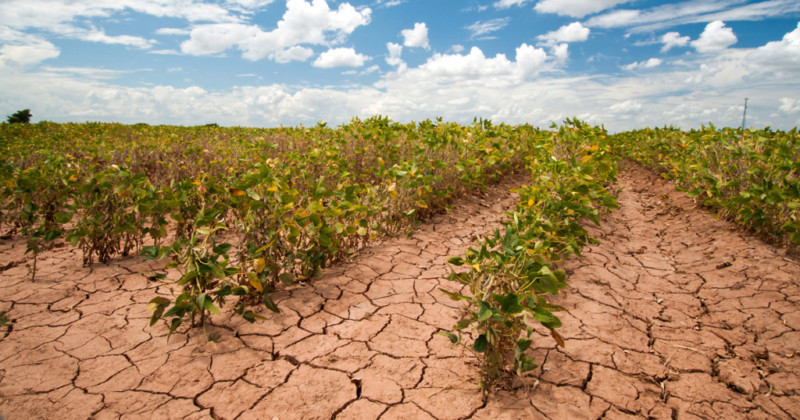The first step in becoming a topsoil expert is as simple as vetting the flour you consume. A Washington company makes that easy

Well grounded: On his farm overlooking the Deschutes River Canyon in Oregon, David Brewer inspects harvested wheat stubble. Brewer and his wheat are part of the Shepherd’s Grain network of no-till farmers. Photo by Jurgen Hess
By Dana Joseph. September 17, 2020. The last thing you probably need with your morning coffee is another existential threat to ponder, this one about the very food you eat and the very ground beneath your feet. Good thing, then, that Kyle Schultheis has your back—and your bagel.
With his dad, Schultheis farms 2,200 acres in the rolling hills of the Palouse in Eastern Washington, about 15 miles south of Pullman in a small town called Colton. They grow winter wheat (soft white and hard red), spring wheat (dark northern, soft white, hard white), food barley, oats, canola, lentils, garbanzo beans, Kentucky bluegrass and hay (beardless barley, grass, alfalfa). He’s the sixth generation to farm here.
“My great-great-great grandfather homesteaded here in 1874—we currently farm some of the original homesteaded ground,” Schultheis says, after a day harvesting the last field of spring wheat.
He’ll haul the wheat to a terminal on the Snake River, where it will be loaded onto barges and shipped to Portland to be exported. Schultheis will spend the majority of the coming days driving a semi-truck back and forth from the field to the river terminal.
MORE: A believable solution for climate change? This no-till film may have it
“A round-trip is two and a half to three hours, so I will make four trips throughout the day,” he says.
He’s making a point of taking the time because as devoted as he is to farming, he’s also devoted to getting out the word about Shepherd’s Grain, a sustainability-focused flour company based in Reardan, Washington.
“A major reason for me wanting to farm was our involvement in Shepherd’s Grain,” says Schultheis.
Meeting the company’s buyers and discovering their appreciation for farming families and the quality of the grain they’re growing helped motivate the former teacher to return to the fields after years in the classroom.
“Soil erosion and degradation is the most neglected environmental crises in the 21st century.” — David Montgomery, University of Washington
“As a kid growing up on a farm, I didn’t understand where the crops we grew went once they were harvested and we dumped them at the local elevator or river terminal,” Schultheis says. “Shepherd’s Grain connected the food chain for us and generated value for the quality grain we were growing and identity-preserving in our grain bins.”
For Schultheis, “identity-preserving” is what makes Shepherd’s Grain special.
“We own 11 of our own grain bins, and throughout harvest I manage them and coordinate which trucks will be taken to our home grain bins and which will go to the local elevators to ultimately be exported as a commodity,” he says.
When it’s loading out of his bins, Schultheis knows exactly where the wheat goes.
“Just last month, my aunt in Portland purchased a 50-pound bag of Shepherd’s Grain low-gluten flour and when she entered the bag code on the website, it showed the wheat used to make the flour was grown on our family’s farm,” says Schultheis.
But there’s more to Shepherd’s Grain than just a bit of flashy technology.
Connecting growers and consumers
Shepherd’s Grain produces and markets a variety of wheat flours—low-gluten, high-gluten, pastry, cake, whole wheat, as well as a food-grade whole flax seed—grown using the no-till method employed by farmers the company actually gets to know.
Karl Kupers and Fred Fleming, the original “shepherds” of Shepherd’s Grain, were Eastern Washington growers who wanted a relationship with the people they sold food to.
“They were tired of the commodity wheat-production system,” says Jeremy Bunch, director of logistics and R&D at Shepherd’s Grain. “They babied their crops along all year, pouring sweat, tears, money, effort and prayers into making sure their crop made it to harvest. Then the crops were quickly harvested and taken to a commercial grain elevator, where the crop was dumped in a pit and kissed goodbye—all with no connection to where that wheat would go and who would eat it.”

Palouse pride: Enter a code on a bag of Shepherd’s Grain flour and you might find the wheat used to produce it comes from a farm like this one in Eastern Washington. Photo courtesy of Shepherd’s Grain
Determined to change that system and reconnect growers and consumers in a regional grain economy—and do so based on sustainable no-till production—Kupers and Fleming started Shepherd’s Grain. This was the early 2000s—the Pacific Northwest was already well known for its foodie culture and environmentalism.
“It was ripe to receive the story of farmers focusing on food quality and environmentally friendly farming practices,” says Bunch.
The name of the company reflects its philosophy. In contrast to systematically farming a monoculture, no-till farming with diversified crop rotations requires a high level of care and management. The idea of a shepherd, paying close attention to each animal, was a fitting analogy for farmers who are paying much more attention to their land.
And to their topsoil.
No-till revolution
Earth’s surface is covered with just a foot or two of topsoil. And we’re losing it at an alarming rate.
Topsoil is more than dirt. Healthy soil teems with life and provides the nutrient layer for vegetation and food from agriculture. The amount and quality of topsoil are directly related to crop yield.
“Soil erosion and degradation is probably the most neglected of the important environmental crises humanity faces in the 21st century,” says David Montgomery, a professor of geomorphology at the University of Washington. He wrote about the effect of soil erosion in 2017’s Growing a Revolution: Bringing Our Soil Back to Life. “Plowing degrades soil organic matter and leaves the soil bare and vulnerable to erosion by wind or rain. Since the dawn of agriculture, humanity has degraded between a quarter and a third of the world’s potential farmland. … We’re on track to degrade another third over the course of the present century.”
But, Montgomery says, we don’t have to repeat the story of ancient civilizations that squandered their soil. “Regenerative farming practices based on no-till farming with cover crops and complex rotations can rebuild soil fertility as a consequence of intensive agriculture.”
No-till is a type of farming that doesn’t disturb the soil. After a field has been harvested, straw, or stubble, is left behind. Tillage incorporates that stubble into the soil, creating a smooth seedbed for the next year’s crop. No-till utilizes special equipment that plants the next year’s crop directly into the previous crop’s stubble. The stubble and roots help prevent soil erosion.
MORE: As water becomes scarce, the influence of water banks grows
Farmers often switch from tilling fields on an annual basis to continuous no-till once they recognize the un-sustainability of losing their topsoil.
“The number of tons of topsoil lost on the Columbia Plateau from erosion due to tillage is astronomical,” Bunch says. “Food-production security depends on soil staying where it’s supposed to so that it can be farmed indefinitely. … Topsoil and agricultural chemicals should not be running off into the Columbia River.”
This isn’t news to Schultheis.
“The decision to begin using no-till was one that my grandpa and dad began experimenting with back in the 1970s,” he says. “The benefits are that we have nearly eliminated soil erosion on our farm, we are able to save all moisture we receive for the crop, there is better water infiltration and we have been able to increase our soil organic matter.”
Pesticides and herbicides
No-till isn’t perfect—or without challenges.
“There is still a lot unknown as to how all the communities of organisms within the soil interact and how they are affected by our farming practices,” says Schultheis.
Shepherd’s Grain growers try to copy the natural ecosystem they farm within. This looks different from farm to farm, and it isn’t always easy to decipher.
“Natural ecosystems contain a great deal of biodiversity below and above ground, and there is a great deal of complexity in how all of those organisms interact with each other,” Bunch says. “No-till farmers try to understand these dynamics, and then take upon themselves the challenging task of trying to mimic those natural systems in food-production systems.”

Growing pains: No-till farming isn’t always this pretty. Absent tilling, weeds present a problem. Photo courtesy of Shepherd’s Grain
Then there’s pesticide and herbicide use, which no-till farmers rely on while trying to mitigate their harmful effects.
Many people ask why Shepherd’s Grain growers aren’t organic. The answer is that sustainability is a higher priority.
“Organic agriculture at scale largely depends on tillage in order to control weeds and other pests,” Bunch says. “Our farmers have committed to saving the soil, and then are working on ways to decrease the use of chemicals. Organic no-till is a wonderful production system. It’s just that we haven’t fully figured out how to do it yet on a number of fronts.”’
As for weeds, Schultheis says the subject is “incredibly complicated.” A fertile growing area that receives ample rainfall is a perfect breeding ground for them.
“Some farmers will say that no-till generates the possibility for more weeds and weed resistance because of our reliance on rotations and herbicide chemistries,” Schultheis says. “However, farmers who utilize tillage still have weeds and use pretty close to the same amount and type of herbicides that no-till farmers do.
“No-till is still a relatively new technology and we are still learning about how to use rotations mixed in with different herbicides to best keep our fields clean each year to help break up the weed cycles.”
“All of our farmers have obtained Food Alliance certification, which is a third-party certification that verifies our growers are farming in environmentally sustainable ways,” Bunch says. “Food Alliance has a list of prohibited pesticides that are particularly damaging to the environment, so our growers are not allowed to use them.”
Bunch adds that because Shepherd’s Grain growers practice no-till, the pesticides they do use stay on the fields rather than eroding off into waterways as they often do in conventional tillage production.
Where to find no-till products
As Shepherd’s Grain and its growers continue to work through those issues, more and more bakers are using the products of their no-till practices.
With locations in the Seattle and Portland metro areas, Grand Central Bakery is a longtime Shepherd’s Grain customer.
“They are an example of a relatively larger bakery that has solid commitments to procuring ingredients that support sustainable farming,” Bunch says. “Sea Wolf is another bakery in Seattle that exemplifies artisan baking at its best. … We are proud of the magic they create with our flours.”

No-till table: St. Honoré Boulangerie uses Shepherd’s Grain flour in many of its baked goods. The popular bakery has four Portland locations. Photo by Jurgen Hess
The grain, the flour, the bread in the oven, the bagel on your plate—in the end, it all comes back to the land and our connection to it. For his part, Schultheis feels good about his family’s stewardship. And his role as a soil shepherd.
“As farmers, we are unbelievably proud of what we do,” he says. “Every decision we make is based on producing the highest quality food for the consumer, while trying to leave the soil in better condition than it was so that my children will have the opportunity to be the seventh generation (of farmers) if they so choose.”
For more information about Shepherd’s Grain, including where to buy its 5-pound bag of all-purpose or whole wheat flour, visit shepherdsgrain.com.








